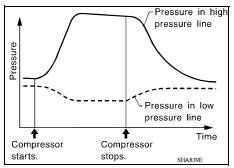 Nissan Versa Sedan Service ManualVentilation, heater & air conditioner » Heater & air conditioning system (HA) » Refrigerant
Nissan Versa Sedan Service ManualVentilation, heater & air conditioner » Heater & air conditioning system (HA) » Refrigerant
Leak Test
Leak Test
CHECK REFRIGERANT LEAKAGE USING FLUORESCENT LEAK DETECTION DYE

- Install a fender cover (1).
- Wear UV safety goggles (2) provided with refrigerant dye leak detection kit.
- Connect power cable (4) of UV lamp (6) to positive and negative terminals of the battery (3).
- Turn on UV lamp switch (5) and check A/C system for refrigerant leakage. (Where refrigerant leakage occurs, fluorescent leak detection dye appears in green color.)
WARNING: Do not look directly into UV lamp light source.
NOTE:
- For continuous operating time of UV lamp, follow the manufacturer operating instructions.
- Illuminate piping joints from different angles using UV lamp and check that there is no leakage.
- Use a mirror in areas that are difficult to see to check for refrigerant leakage.
- Refrigerant leakage from evaporator can be detected by soaking cotton swab or a similar material with drain hose water and illuminating it using UV lamp.
- Dust, dirt, and packing materials adhesive used for condenser, evaporator, and other components may cause fluoresce. Be careful not to misidentify leakage.
- Repair or replace parts where refrigerant leakage occurs and wipe off
fluorescent leak detection dye.
NOTE: Completely wipe off fluorescent leak detection dye from gaps between parts, screw threads, and other items using a cotton swab or similar materials.
- Use a UV lamp to check that no fluorescent leak detection dye remains
after finishing work.
WARNING: Do not look directly into UV lamp light source.
NOTE:
- For continuous operating time of UV lamp, follow the manufacturer operating instructions.
- Dust, dirt, and packing materials adhesive used for condenser, evaporator, and other items may cause fluoresce. Be careful not to misidentify leakage.
CHECK REFRIGERANT LEAKAGE USING ELECTRICAL LEAK DETECTOR
WARNING: Do not check for refrigerant leakage while the engine is running.
CAUTION: Be careful of the following items so that inaccurate checks or misidentifications are avoided.
- Do not allow refrigerant vapor, shop chemical vapors, cigarette smoke, etc. around the vehicle.
- Always check refrigerant leakage in a low air flow environment so that refrigerant may not disperse when leakage occurs.
- Stop the engine.
- Connect recovery/recycling/recharging equipment or manifold gauge set to A/C service valve.
- Check that A/C refrigerant pressure is 345 kPa (3.52 kg/cm2, 50 psi) or
more when temperature is 16C
(61F) or more. When pressure is lower than the specified value, recycle
refrigerant completely and fill
refrigerant to the specified level.
NOTE: Leakages may not be detected if A/C refrigerant pressure is 345 kPa (3.52 kg/cm2, 50 psi) or less when temperature is less than 16C (61F).
- Clean area where refrigerant leakage check is performed, and check refrigerant leakage along all surfaces of pipe connections and A/C system components using electrical leak detector probe.
CAUTION:
- Continue checking when a leak is found. Always continue and complete checking along all pipe connections and A/C system components for additional leakage.
- When a leak is detected, clean leakage area using compressed air and check again.
- When checking leakage of cooling unit inside, always clean inside of drain hose so that the probe surface is not exposed to water or dirt.
NOTE:
- Always check leakage starting from high-pressure side and continue to low-pressure side.
- When checking leakage of cooling unit inside, operate blower fan motor for 15 minutes or more at the maximum fan speed while the engine is stopped, and then insert electrical leak detector probe into drain hose and hold for 10 minutes or more.
- When disconnecting shut-off valve that is connected to A/C service valve, always evacuate remaining refrigerant so that misidentification can be avoided.
- Repair or replace parts where refrigerant leakage is detected. (Leakage is detected but leakage area is unknown. GO TO 6.)
- Start the engine and set A/C control in the following positions.
- A/C switch ON
- Air flow: VENT (ventilation)
- Intake door position: Recirculation
- Temperature setting: Full cold
- Fan speed: Maximum speed set
- Run the engine at approximately 1,500 rpm for 2 minutes or more.
- Stop the engine. Check again for refrigerant leakage. GO TO 4.
WARNING: Be careful not to get burned when the engine is hot.
NOTE:
- Start refrigerant leak check immediately after the engine is stopped.
- When refrigerant circulation is stopped, pressure on the lowpressure side rises gradually, and after this, pressure on the high-pressure side falls gradually.
- The higher the pressure is, the easier it is to find the refrigerant leakage.

